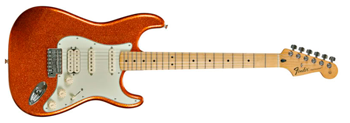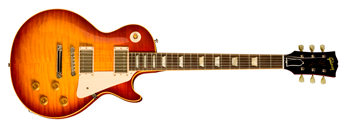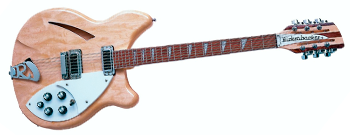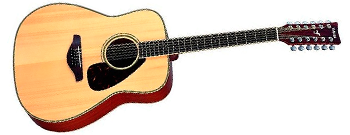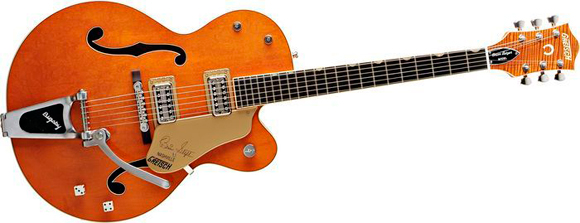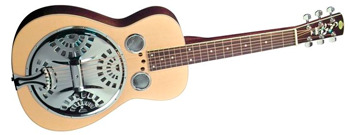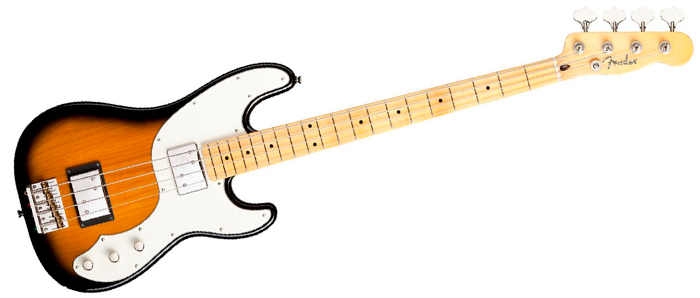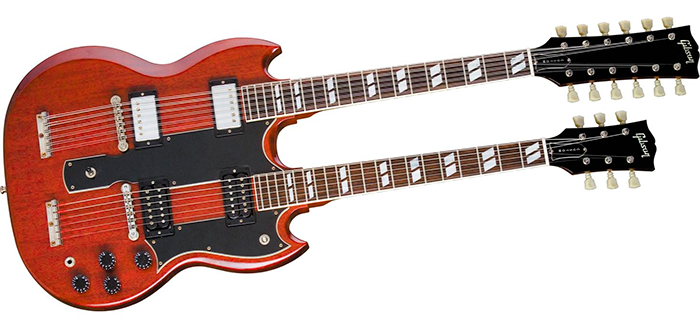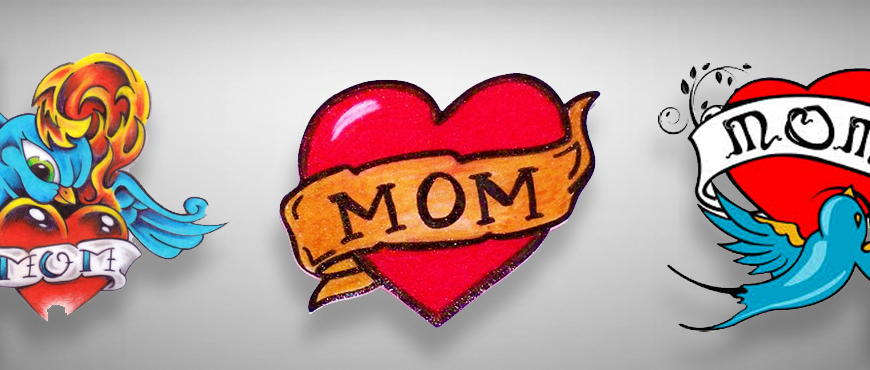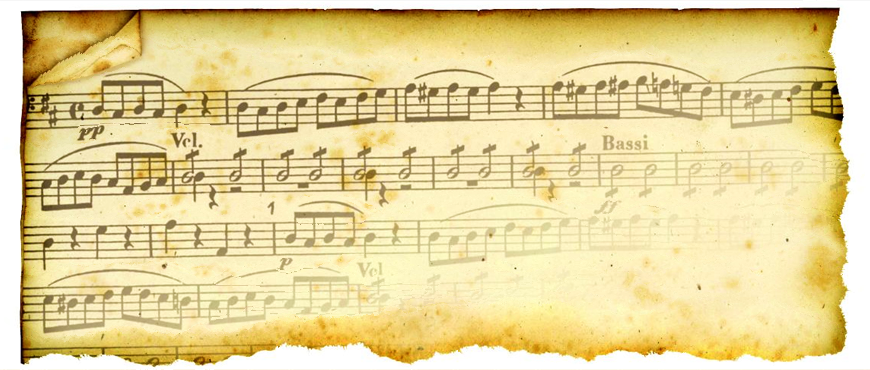6 Sick Steve Vai Licks
March 26, 2015Fast Blues Scale Lick
March 27, 2015Types of Guitars
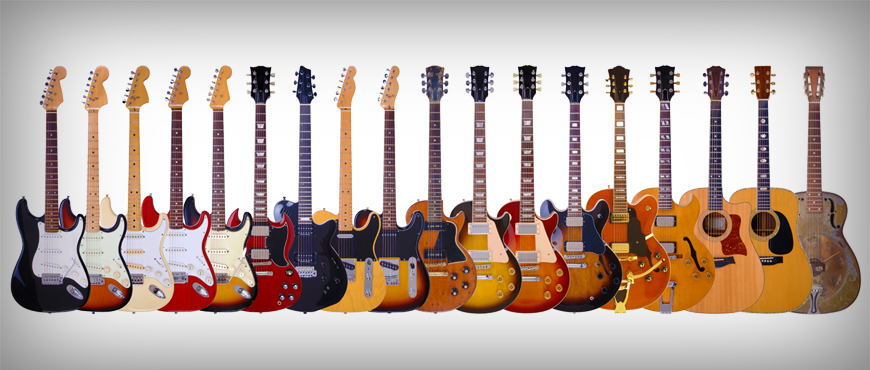
There are many different types of guitars in the world to choose from.
There are electric guitars, acoustic guitars, and even electric/acoustic guitars.
There are bass guitars that sound low, resonator guitars that sound like banjos, and 12 string guitars that sound almost like two guitars.
Let’s take a look at some of the many different guitars available.
Acoustic Guitars
Acoustic Guitars can be divided into two catagories: classicals and steel-strings
[one_half padding=”0 5px 0 5px”]
Classical Guitar
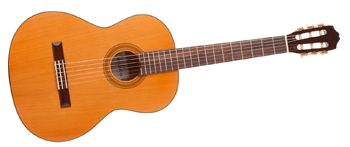
[/one_half]
[one_half_last padding=”0 5px 0 5px”]
Steel-String Guitar

[/one_half_last]
[one_half padding=”0 5px 0 5px”]
Classical Guitars (also known as Spanish guitars) are typically strung with nylon strings, plucked with the fingers, played in a seated position and are used to play a diversity of musical styles including classical music.
The classical guitar’s wide, flat neck allows the musician to play scales, arpeggios, and certain chord forms more easily and with less adjacent string interference than on other styles of guitar.The flamenco guitar is similar to the classical guitar, but of lighter construction, with a cypress body and spruce top. A distinguishing feature of all flamenco guitars is the tapping plates glued to the table, to protect them against the taps with the fingernails that are an essential feature of the flamenco style.
[/one_half]
[one_half_last padding=”0 5px 0 5px”]
Flat-top or Steel-string Guitars are similar to the classical guitar, however, within the varied sizes of the steel-stringed guitar the body size is usually significantly larger than a classical guitar, and has a narrower, reinforced neck and stronger structural design.
The steel strings produce a brighter tone, and according to many players, a louder sound. The acoustic guitar is used in many kinds of music including folk, country, bluegrass, pop, jazz, and blues. Many variations are possible from the roughly classical-sized OO and Parlour to the large Dreadnought and Jumbo. Ovation makes a modern variation, with a rounded back/side assembly molded from artificial materials.
[/one_half_last]

Electric Guitars
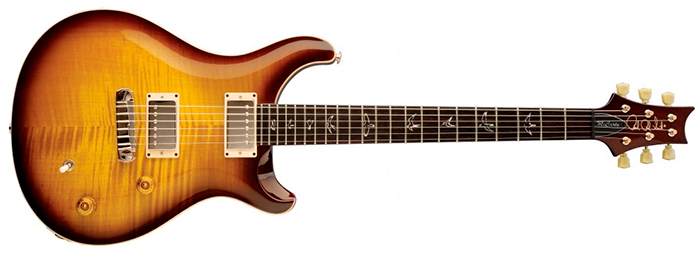 Paul Reed Smith (PRS)
Paul Reed Smith (PRS)
The Electric Guitar is the workhorse of rock, blues, jazz and pop music. Electric guitars need to be plugged into an amplifier to be heard adequately. They are usually solid-body guitars but archtop electric guitars with hollow bodies are available which gives them some acoustic resonance. The electric guitar when amplified has a sound that is metallic with a lengthy decay (sustain).
The design of the electric guitar is not determined by the need for a deep resonating body (acoustic chamber) and this had led to the development of contoured and thin bodied electric guitars. The two most popular designs are the Fender Stratocaster and the Gibson Les Paul.
[one_half padding=”0 5px 0 5px”]
Fender Stratocaster
[one_half_last padding=”0 5px 0 5px”]
Gibson Les Paul
The strings of an electric guitar are thinner than acoustic strings and closer to the neck; therefore less force is needed to press them down. The ease with which you can bend strings, clear access to the twelfth fret and above, the use of a whammy bar and manipulation of pots and switches whilst playing has led to the development of a lead guitar style that is difficult to recreate on acoustics. Fret-tapping is a guitar technique for creating chords and melody lines that would not be possible using the standard technique of left-hand fretting and right-hand strumming. The electric guitar’s sustain, sensitive pick-ups, low action and thin strings make it an ideal instrument for fret-tapping.
The choice of which amplifier to buy is usually one of personal preference. Marshall amps and cabs are renowned for their “over-driven” valve distortion while Fender valve amps are known for their “clarity” and “warmth”. The Marshall rig is synonymous with rock music while Fender amps are popular with blues and country guitarists. There are many other manufacturers besides Marshall and Fender and the buyer is advised to read about the equipment of his favorite guitarists and to test different amps and cabs before purchasing. See the Amplifier section for details.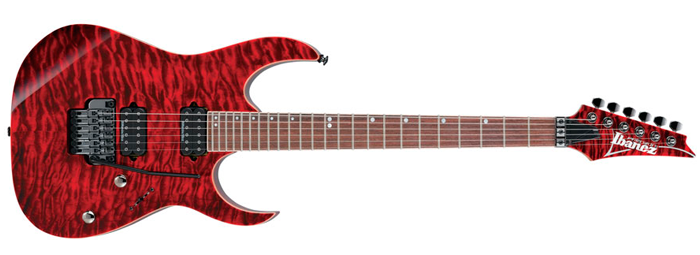
Electric/Acoustic Guitars
[one_half padding=”0 5px 0 5px”]
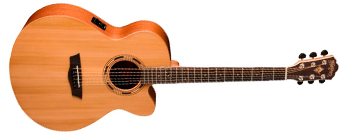
[/one_half]
[one_half_last padding=”0 5px 0 5px”]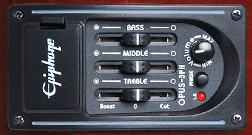
Electric acoustic control panel
[/one_half_last]
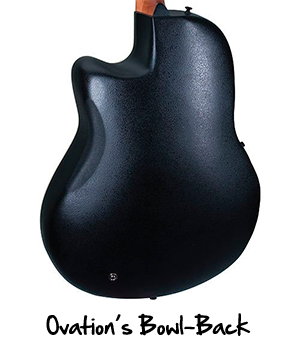 Electric-Acoustic Guitars have pickups specifically designed to reproduce the subtle nuances of the acoustic guitar timbre. This allows electric-acoustics to be plugged into an amp or house PA.
Electric-Acoustic Guitars have pickups specifically designed to reproduce the subtle nuances of the acoustic guitar timbre. This allows electric-acoustics to be plugged into an amp or house PA.
The Ovation range of electric-acoustics use under-the-saddle piezo pickups and a synthetic bowl-back. Ovation’s synthetic bowl-back ensures a tough construction that stands up to the rigours of the road and offers less feedback at high volumes. Ovation were the first company to provide on-board equalization and this is now a standard feature on most electric-acoustics.
Electric-acoustic pickups are designed to sound neutral with little alteration to the organic acoustic timbre.
Another electric-acoustic brand is the Taylor guitar range. Taylor uses the traditional all-wood construction and the necks of these guitars have a reputation for superb action and playability. Yamaha, Maton and many other companies make electric-acoustics and the buyer is advised to test as many models and makes as they can; taking note of the unplugged and amplified sound.
12 String Guitars
[one_half padding=”0 5px 0 5px”]
Electric 12 String
[one_half_last padding=”0 5px 0 5px”]
Acoustic 12 String
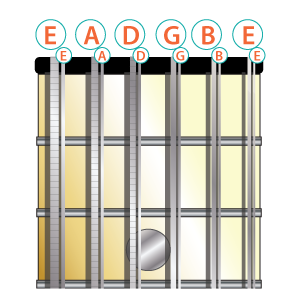 The Twelve-String Guitar is a simple variation of the normal six string design. Twelve-string guitars have the regular six strings and a second set of thinner strings. Each string of the second set corresponds to the note of its regular string counterpart. The strings form pairs; so you still play the guitar in the same manner as a standard six-string.
The Twelve-String Guitar is a simple variation of the normal six string design. Twelve-string guitars have the regular six strings and a second set of thinner strings. Each string of the second set corresponds to the note of its regular string counterpart. The strings form pairs; so you still play the guitar in the same manner as a standard six-string.
Twelve-string guitars produce a brighter more “jangly” tone than six-string guitars. They are used by guitarists for chord progressions that require “thickening”. Having two strings per note makes bending notes more difficult. Though you can play lead guitar; the extra effort involved means that the twelve-string guitar is mainly used as a rhythm instrument.
Twelve-string guitars are slightly more expensive then their corresponding six-string version. Studio players and professionals will normally have a twelve-string guitar in their collection for their distinctive sound which is found on many famous recordings. The Beatles and The Byrds sometimes used Rickenbacker twelve-string electrics and Jimi Hendrix’s performance of Hear My Train A Comin’ on an acoustic twelve-string allows the student to hear the solo instrument.
Archtop Guitars
Archtop Guitars are steel-string instruments in which the top (and often the back) of the instrument are carved from a solid billet in a curved rather than a flat shape; this violin-like construction is usually credited to the American Orville Gibson (1856–1918). Lloyd Loar of the Gibson Mandolin-Guitar Mfg. Co introduced the violin-inspired f-hole design now usually associated with archtop guitars, after designing a style of mandolin of the same type.
The typical archtop guitar has a large, deep, hollow body whose form is much like that of a mandolin or violin family instrument. Nowadays, most archtops are equipped with magnetic pickups and are therefore both acoustic and electric. F-hole archtop guitars were immediately adopted upon their release by both jazz and country musicians and have remained particularly popular in jazz music, usually with flatwound strings.
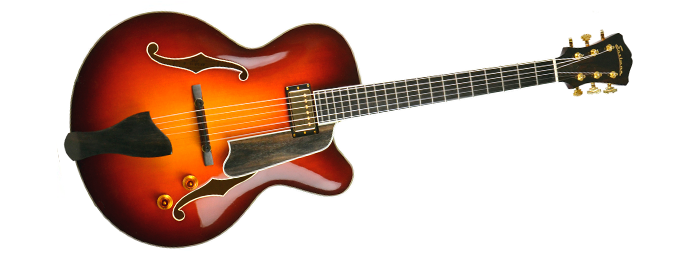
Resonator Guitar
[one_half padding=”0 5px 0 5px”]
Wooden Resonator Guitar
[one_half_last padding=”0 5px 0 5px”]
Metal Resonator Guitar
 The Acoustic Resonator Guitar is distinctive in not having a regular sound hole. Resonator guitars have a large, usually circular-plate which conceals the resonator cone. The cone closely resembles an audio loudspeaker and is made from spun aluminium. The bridge of the guitar is connected either to the centre of the cone or to the edge by an aluminium ‘spider’ and the strings’ vibrations are thus amplified and projected outwards through the perforated plate on the guitar’s top. The most common resonator guitars have a single cone, although the original model has three.
The Acoustic Resonator Guitar is distinctive in not having a regular sound hole. Resonator guitars have a large, usually circular-plate which conceals the resonator cone. The cone closely resembles an audio loudspeaker and is made from spun aluminium. The bridge of the guitar is connected either to the centre of the cone or to the edge by an aluminium ‘spider’ and the strings’ vibrations are thus amplified and projected outwards through the perforated plate on the guitar’s top. The most common resonator guitars have a single cone, although the original model has three.
Resonators possess a loud, bright voice, making them easily heard in a large room or open air performance. They are popular with blues musicians and country players and can be played in the conventional style or with a metal or glass slide.
Some resonator guitars possess metal bodies and these are called steel guitars. This can lead to some confusion with the Hawaiian guitar of the same name. They are two distinct instruments; the Hawaiian steel guitar takes its name from the steel bar used to create the glissandi and the Resonator steel guitar refers to the material used in the construction of the body.
Bass Guitars
The Bass Guitar has a long scale-length (neck) and thick strings. These factors create a range of notes that corresponds to the lowest four strings of the guitar though pitched an octave lower. The bass is part of the rhythm section and rarely takes a front role. Jaco Pastorius and Stanley Clarke are two bassists renowned for their virtuoso bass playing.
Acoustic bass guitars are available though the electric bass is more common. The standard bass has four strings though five and six string basses are available; extending the range of the instrument and allowing a wider harmonic and melodic technique. Though the bass guitar is the bass instrument of the guitar family and the double-bass (upright) is the bass instrument of the orchestral string family; their similar roles has drawn bass players to both instruments. Two influential upright bass players are Willie Dixon and Ray Brown.
Double Neck Guitars
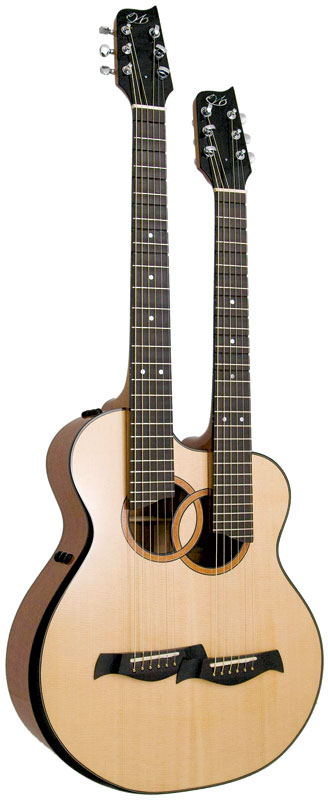 The Double-neck Guitar is two different kinds of guitar sharing one body. This design allows the guitarist to switch between either neck with ease. The double-neck guitar will normally have a standard six-string neck and a twelve-string neck though other combinations exist; such as the six-string and bass or the six-string and fretless neck.
The Double-neck Guitar is two different kinds of guitar sharing one body. This design allows the guitarist to switch between either neck with ease. The double-neck guitar will normally have a standard six-string neck and a twelve-string neck though other combinations exist; such as the six-string and bass or the six-string and fretless neck.
The double-neck electric guitar was available in the 1950s and 1960s with models like the Gretsch 6025 Bikini twin-neck of 1961 though it wasn’t until the 1970s that its popularity and visibility increased with its use by rock guitarists such as Jimmy Page of Led Zeppelin. The double-neck guitar is ideal for live concerts where the guitarist has to recreate a multi-tracked guitar recording.

